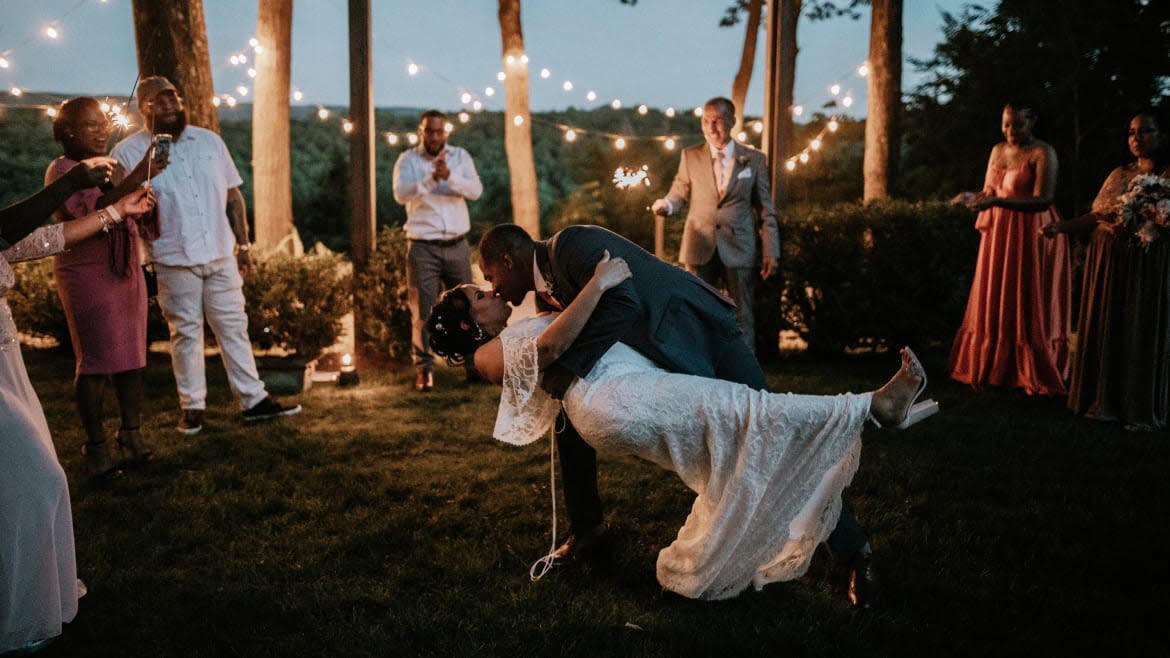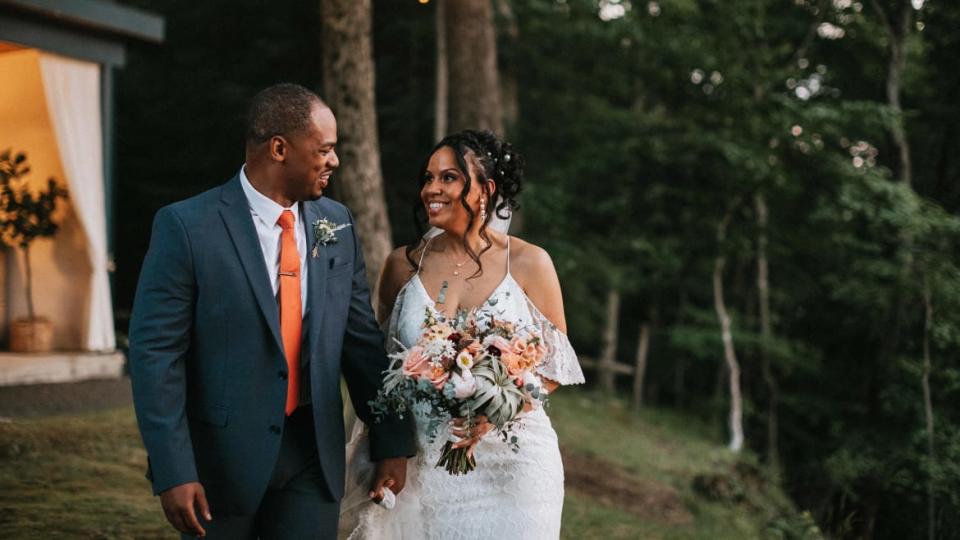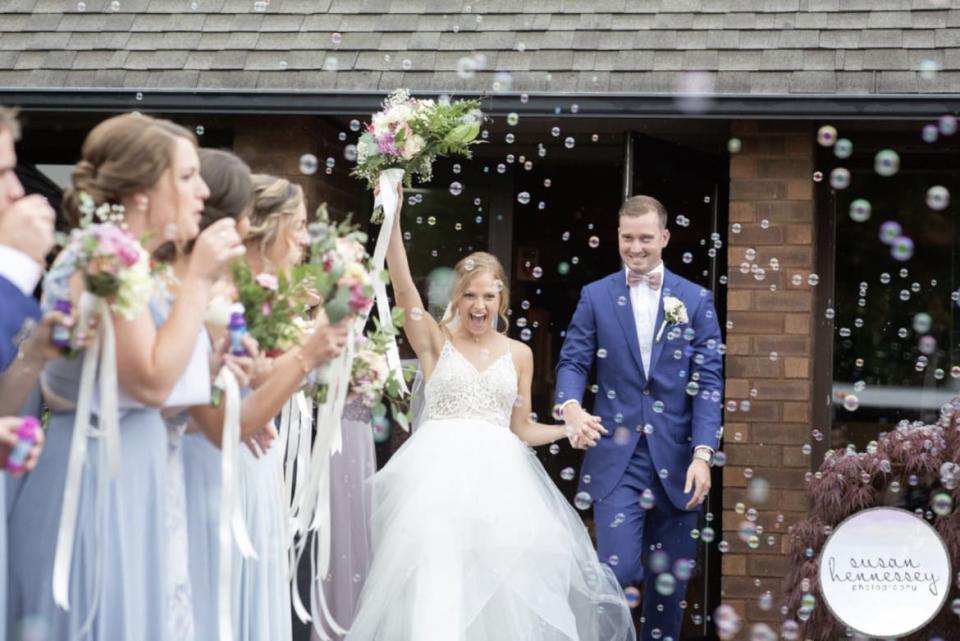COVID-19 Didn’t Kill Weddings. But It May Change Them Forever.

Lee Hanyo and his now-wife Megan planned to have a big destination wedding in Arizona this May. Then, the novel coronavirus hit. But instead of pushing their marriage back, like many couples in their position have opted to do, the “Phase Green” Pittsburgh natives decided to keep their day, but plan a new, smaller and safer wedding from scratch.
“We replanned our whole entire wedding in four weeks,” Hanyo told The Daily Beast. “We ended up getting married at her family’s cabin [in Pennsylvania.] It’s right on the river. It’s really special to her,” he said.
Everything stayed true to their vision with the exception of their guest count, which ended up totaling 26 people, and the location. Yet those were the wild cards that seemed to work out in their favor—even the special mini cacti centerpieces on each table as an homage to the first wedding.
“We were able to be in the moment more. It made it better for us,” he said.
As COVID-19 cases continue to rise across the country, people like Hanyo are learning first-hand that the former wedding rules and laws no longer apply.
According to data provided to The Daily Beast from wedding website The Knot’s global COVID-19 survey—which surveyed users in the U.S, Canada, Spain, Italy, France, Portugal, Brazil, and Mexico in May 2020—approximately 675,000 weddings in the U.S. were affected by the coronavirus between March and June of this year. That number is expected to hit one million by the end of 2020.
The survey also found that the majority of couples have either postponed or not made a decision on how they're moving forward with their reception at this time. Only 7 percent of wedding receptions were canceled. In other words, weddings are still happening, but everyone's “big” day may actually resemble something, well, much smaller.
Enter the microwedding.

According to The Knot, a microwedding “will typically include a guest list of up to 50 guests—often immediate family and super-close friends only.” It’s different from what they call a “minimony,” where a couple has a small ceremony first and a larger one later and an elopement which is done without virtually any other guests but an officiant and witness.
What used to be off-the-beaten-path choices in an almost $5 billion per year industry—which places value on large ballrooms and an average of 130-people guest counts—has turned into a trend thanks to the pandemic.
The question is, are these laissez-faire nuptials here to stay?
The data is still being collected on the choice to have microweddings in lieu of larger, more traditional ones, but industry trend articles, as well as vendors I spoke to, suggest that after COVID hit, microweddings or “minimonies” have been catching on. People have resorted to marriage ceremonies on stoops, in parks, and on sidewalks.
Heck, some have gotten celebrities like Hoda Kotb and Lupita Nyong’o to officiate or stand witness to their big day.
For some, the choice to have a smaller wedding comes down to COVID, and COVID alone, with many couples opting to have the “minimony,” aka the ceremony now and keep the big party, just on a later date.
Carly Crockett from Hampton, Virginia, made this choice. She plans on having a bigger wedding in August but opted to still tie the knot on her original date.
“We really liked 7/11. We wanted like a month where we would get married in July,” she explained. “It’s better to do it and get it down with and we can have a big party later. It kinda just makes it more intimate—a lot more personal, which is what I’m looking forward to.”
That’s exactly the vibe of the “minimony” that photographer Susan Hennessey shot in Long Beach Island for a New Jersey couple whose original plans had been “displaced” by the pandemic.
“The wedding had a bridal party, immediate family, some friends,” she explained. “We did a nice bubble exit. We had perfect lighting. I suggested that it might be nice to do a champagne toast so it still feels like a wedding.”
For those that have ditched the big day altogether and are embracing the new normal, it has been a blessing in disguise.
While talking to a friend’s neighbor from Philadelphia recently, she explained a friend of hers took their would-be wedding money and bought a house instead. “They’re super-happy,” she said.
Becca Dilley, a 14-year wedding photographer from Minneapolis, Minnesota, feels the shift has a good chance of being permanent.
“It’s almost to me like it's sort of like a crystallization of some things that have been happening before,” she said, saying that personalization and the ceremony itself have been slowly becoming more important to couples when planning out their day.
“I think it’s going to have long-lasting effects on how people view weddings going forward, in terms of size and the components that make a wedding and what components are meaningful to us as a couple,” she added.
In fact, Dilley said that she will be buying a GoPro so she can livestream future weddings she books: “For the weddings I’ve been at, often I am the big wedding expense. It makes sense to have options for people who can’t attend the wedding.”

Deborah Moody, executive director of the Association of Certified Professional Wedding Consultants, echoed that sentiment.
“Things are definitely going to change,” she told The Daily Beast. “There’s going to be a trend of more livestreaming. The number of people you invite to your wedding will be smaller.”
Venues are adapting as well. The Boston Public Library announced in June a special microwedding package to couples. For $5,000, the bride and groom and up to eight guests can have 90 minutes for the ceremony and reception in the Central Library building’s outdoor courtyard.
Pre-COVID, Alisa Tongg, a celebrant based in Pennsylvania, transformed her backyard overlook into a stunning microwedding or elopement wedding space. But now, it’s become a refuge for displaced couples and an appealing option moving forward.
“I think people will continue to be interested in microweddings, and not as the COVID solution,” she said. Though she admitted that it’s not a viable option for all vendors, who rely on headcount to make their money, it’s still a great option. “You don’t need a dance party for your wedding to be a complete experience.”
If there is no containment for a while, couples may not have a choice. Moody says that the industry is already shifting to customs that err on the side of caution, from dance floors in different rooms to temperature checks, weekday weddings and even safety waivers.
“Buffets will go ‘good-bye,’” she said.
In Britain, the effects of the virus have already forced people to adapt to new rules: Dads can no longer walk their daughters down the aisle.
The economy certainly plays a role in a potential industry shift, too, and maybe for the better. An average wedding expense of $24,000 doesn’t exactly mesh well with an unemployment rate of a record 13 percent. Pre-pandemic, venues could charge more than $150 per head and our Pinterest-obsessed culture has been filled with expensive “must-haves” that could break the bank. Now, couples have access, without as much judgment.
Tongg, for example, charges $2,750 for a 20-person microwedding of 90 minutes, including the ceremony and a dinner.
“I was talking to [a] bride and we were going over the cake that she wants and said that she felt that I was bringing equity to people,” she recounted. “You don't have to follow the ‘shoulds’ of what the wedding industry is following people to do.”
But where clients win, vendors may lose, as the financial setbacks faced by those who make a living from traditional weddings can be crippling. It’s this that has Hennessey hoping things in the industry go back to as they were in the “before” times. She has confidence they will “bounce back,” explaining that people may still want to have the company of their loved ones on their special day in a way a smaller wedding could not provide.
“The people who do cut their list, they do miss those people,” she said.
Tongg's prediction: that things won’t shift one way or another; couples will simply have more options. “People planning now [have] an opportunity to step back and reimagine what their end goal is without being told what their end goal should be,” she added. “Everything is on the table.”
Of course, it’s all dependent on safety, period. “I would prefer that I go out of business and not have a catastrophic level of death,” says Dilley. “Obviously that sucks for me, but I just can’t imagine [the alternative].”

Moody has a more realist approach.
“Even if you postpone your wedding until next year there are certain requirements that are going to [have to] be met,” she said. “Your dream has to be revamped.”
Does it have to be a bad thing? Not quite. “We’re learning to appreciate the people who are really important,” she added. “If you go to a wedding with 300 people and you go to a wedding with 75 people, you're probably going to have more fun at the one that was smaller.”
As a COVID groom who wanted, and planned, two different kinds of weddings in a post-and pre-pandemic-stricken world, Hanyo has seen both sides of the coin. And while he understands the appeal of a traditional wedding, there is one significant perk of this new normal: less stress.
“My wife and I were definitely way more relaxed that day. It was a very chill morning," he laughed.
Get our top stories in your inbox every day. Sign up now!
Daily Beast Membership: Beast Inside goes deeper on the stories that matter to you. Learn more.

